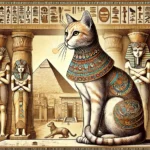Pets have long held a cherished place in the hearts of readers and writers alike, serving as more than just companions in the lives of their human counterparts.
They often embody profound themes, evoke deep emotions, and act as silent witnesses to the intricacies of human experiences within the pages of literature.
From the loyal hound in Homer’s “The Odyssey” to the enigmatic cat in Edgar Allan Poe’s tales, animals enrich narratives with their unique perspectives and unconditional love.
This blog post delves into the multifaceted impact of pets in literature, exploring how they have shaped storytelling throughout the ages, offered solace in times of turmoil, and provided a lens through which we examine our own humanity.
Historical Perspectives on Pets in Literature
Throughout history, pets have played a significant role in literature, serving not only as companions but also as symbols, motifs, and catalysts for character development.
In ancient texts, such as the works of Homer, animals were often depicted as loyal companions, embodying virtues like fidelity and courage.
The famous tale of Odysseus and his faithful dog, Argos, illustrates the deep bond between humans and pets, highlighting themes of loyalty that resonate throughout literary history.
During the Middle Ages, animals served as allegorical figures in fables and moral tales.
Aesop’s Fables, for instance, brought a host of creatures to life, each conveying essential moral lessons through their interactions with humans.
These stories not only entertained but also educated readers, embedding the notion of pets as vessels for deeper truths about human nature.
As literature evolved into the Renaissance and beyond, pets began to reflect the social status and personal identity of their owners.
In works like “The Count of Monte Cristo” by Alexandre Dumas, the presence of animals often signifies wealth, sophistication, or even innocence.
Meanwhile, the romantic poets, such as John Keats and William Wordsworth, celebrated the simplicity and authenticity found in the bonds between humans and their pets, drawing attention to the emotional and therapeutic benefits they provide.
In the 19th century, the rise of the domestic novel further solidified the role of pets in storytelling.
Authors like Charles Dickens and Charlotte Brontë incorporated animals into their narratives, using them as devices to evoke empathy and highlight social issues.
Pets became symbols of innocence amidst the harsh realities of life, often serving as the emotional anchors of their human counterparts.
Today, the impact of pets in literature continues to thrive, as writers explore the complex relationships between humans and animals.
From heartwarming tales of companionship to poignant narratives reflecting loss and grief, pets are woven into the fabric of storytelling, enriching the narrative with layers of meaning that resonate with readers across generations.
As we seek to understand our own relationships with pets, literature serves as a mirror, reflecting the profound and often transformative impact these beloved companions have on our lives.
Symbolism and Themes Associated with Pets
Pets have long served as powerful symbols in literature, embodying a range of themes and emotions that resonate with readers.
Their presence often transcends the simple companionship they provide, delving into deeper explorations of loyalty, innocence, and the complex bond between humans and animals.
For instance, in many narratives, a pet may symbolize unconditional love and fidelity, acting as a mirror to human relationships.
Think of the loyal dog in classic tales like Jack London’s “The Call of the Wild,” which not only highlights the theme of survival but also underscores the bond between species in the face of adversity.
In contrast, pets can also represent innocence and the vulnerability of childhood.
In works such as “Charlotte’s Web” by E. B. White, the relationships between the characters and their pets reflect themes of friendship, loss, and the bittersweet nature of growing up.
Here, the pig Wilbur’s journey is not just about farm life; it serves as an allegory for the deeper struggles of identity and acceptance, with his friendships with other animals evoking empathy and compassion.
Moreover, pets often embody themes of freedom and escape.
In many stories, they provide a means of liberation for their human counterparts, offering solace and an emotional refuge from the harsh realities of life.
This can be seen in novels like “The Incredible Journey” by Sheila Burnford, where the journey of two dogs and a cat highlights their unwavering determination and resilience, symbolizing hope and the pursuit of belonging.
Ultimately, the role of pets in literature extends far beyond mere companionship; they are crucial narrative devices that enrich the storytelling experience.
By embodying essential human traits and values, pets not only enhance character development but also encourage readers to reflect on their own relationships and the profound connections we share with animals.
Through their symbolism, they remind us of what it means to love, to lose, and to find our way back home.
Case Studies: Notable Pets in Classic Literature
Pets have long held a cherished place in literature, serving as companions, symbols, and sometimes even catalysts for character development.
In classic literature, notable pets often embody deeper themes, adding richness to the narratives and enhancing the emotional depth of the stories.
One of the most iconic examples is Toto, Dorothy’s faithful dog in L.
Frank Baum’s The Wonderful Wizard of Oz. Toto’s unwavering loyalty not only provides comfort to Dorothy but also serves as a grounding force that keeps her connected to her home in Kansas.
As she navigates the enchanting yet perilous Land of Oz, Toto’s presence reminds readers of the importance of companionship and the instinctual bond between humans and their pets.
Another poignant case is found in The Great Gatsby by F. Scott Fitzgerald, where Daisy Buchanan’s cat appears briefly yet symbolically.
The cat’s presence underscores the complexities of Daisy’s character—both frivolous and deeply longing for authenticity.
It subtly highlights the contrasting worlds of wealth and emotional desolation that permeate the narrative, amplifying the sense of isolation experienced by the characters.
Additionally, consider the role of Marley, the eponymous Labrador in John Grogan’s Marley & Me.
Although a contemporary piece, this memoir reflects classic elements of pet literature.
Marley serves as an embodiment of unconditional love and the chaos of life itself.
His antics and the lessons he imparts about loyalty, love, and loss resonate with readers on a deeply personal level, illustrating how pets can mirror the complexities of human relationships.
These case studies show that pets in classic literature are not merely side characters; they are integral to the storytelling process.
They enrich the narrative landscape, providing insight into the human condition and evoking emotional responses that resonate with readers across generations.
Through their roles, these literary pets help illuminate themes of love, loyalty, and the often tumultuous journey of life, reminding us of the profound impact that animals have on our stories—and our lives.
The Role of Pets in Contemporary Storytelling
In contemporary storytelling, pets have evolved from mere companions to pivotal characters that enrich narratives and deepen connections between readers and protagonists.
Their presence often symbolizes loyalty, love, and the complexity of human emotion, serving as mirrors to the inner lives of their owners.
Authors skillfully employ pets not only to provide comfort or comic relief but also to highlight themes of companionship, loss, and resilience.
For instance, in modern fiction, a dog might serve as a character’s sole confidant, illustrating feelings of isolation or emotional turmoil, while also offering unconditional support.
This relationship can be particularly poignant in stories dealing with grief or recovery, where the pet often becomes a catalyst for healing and a source of motivation for the main character to move forward.
Moreover, contemporary narratives frequently explore the idea of pets as active participants in the story.
Books and films like “A Dog’s Purpose” or “The Art of Racing in the Rain” present unique perspectives through the eyes of the pet, allowing readers to experience the world from a different vantage point.
This not only enriches the storytelling but also fosters empathy and a deeper understanding of the human condition.
In addition to their emotional contributions, pets in contemporary literature often challenge societal norms or expectations.
They can serve as symbols of rebellion, freedom, or even innocence in stories that critique modern life, reminding readers of simpler joys amid chaos.
By weaving pets into the fabric of their narratives, authors create multifaceted stories that resonate with readers on multiple levels, ultimately reinforcing the timeless bond between humans and animals.
In doing so, they highlight the profound ways in which pets shape our lives and influence our journeys, making them indispensable to modern storytelling.
Emotional Impact: How Pets Reflect Human Experiences
Pets have long served as powerful symbols in literature, representing a myriad of human experiences and emotions that resonate deeply with readers.
Their presence often serves to mirror the complexities of human relationships, encapsulating feelings of love, loyalty, grief, and joy.
Through the bond between pets and their owners, authors skillfully explore themes of companionship and devotion, providing insight into the characters’ emotional landscapes.
For instance, in stories like “The Call of the Wild” by Jack London, the relationship between Buck and his owner illustrates the struggle for survival and the inherent instinctual ties that bind us to our roots.
Similarly, in “Charlotte’s Web” by E. B. White, the friendship between Wilbur the pig and Charlotte the spider showcases the beauty of selflessness and the profound connections that can form even in the most unlikely circumstances.
These narratives evoke a range of emotions, from the heartwarming moments of companionship to the poignant grief felt at a pet’s passing.
Additionally, pets often serve as a catalyst for character development.
Their unconditional love offers solace and comfort during tumultuous times, highlighting the importance of emotional support in overcoming life’s challenges.
Through the lens of a pet’s unwavering loyalty, readers can better understand the human condition, grappling with themes of loss, resilience, and the search for belonging.
Ultimately, pets in literature not only enrich the narrative but also invite readers to reflect on their own experiences.
They remind us of the emotional depth of our relationships and the shared journey of life, making their portrayal in storytelling an indispensable element of literature’s emotional impact.
Whether through laughter or tears, the presence of pets in stories allows us to connect with our own experiences, forging a bond that transcends the page.
Conclusion: The Enduring Legacy of Pets in Literature
As we close our exploration of the impact of pets in literature, it becomes clear that their presence transcends mere companionship; they serve as powerful symbols that enhance storytelling and enrich the emotional landscape of narratives.
From the loyal hound following its master into battle to the mischievous cat stirring trouble in a quiet household, pets embody traits that resonate deeply with readers.
They bridge the gap between the human experience and the animal world, reminding us of our innate desire for connection, loyalty, and understanding.
The enduring legacy of pets in literature speaks to their ability to reflect our struggles, joys, and the complexities of life.
They are not just background characters; they play pivotal roles that often drive the plot forward or lead to transformative moments of introspection for the protagonists.
Whether through the whimsical adventures of a pet in children’s stories or the profound themes of loss and love encapsulated in adult fiction, these animals leave an indelible mark on our hearts and minds.
Ultimately, the stories we create and cherish will always be intertwined with the presence of our furry, scaly, or feathered friends.
As we continue to write and read, let us remember that pets do more than merely populate pages; they enrich our narratives with their loyalty, wisdom, and companionship, reminding us of the beauty and complexity of the bond we share with them.
In literature, as in life, pets will forever remain an essential part of our storytelling tapestry, weaving threads of love, adventure, and resilience into the fabric of human experience.


